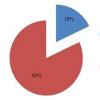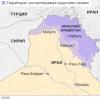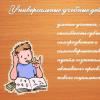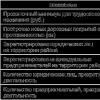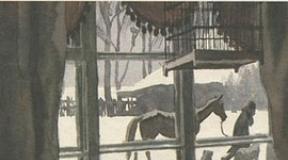Cattell's test results on scales chart. Cattell's Questionnaire: a method of multivariate personality research in the selection of candidates. Processing and Interpretation of Test Results Key to Cattell's Factor Theory of Personality
| Primary Factors | |
| I. Factor "A" (focused on determining the degree of sociability of a person in a group) |
|
| "-" "Schizothymia" | "+" "Affectothymia" |
| secretive, isolated, critical, adamant, uncommunicative, withdrawn, indifferent, defends his ideas, aloof, precise, objective, distrustful, skeptical, cold (hard), angry, gloomy | warm-hearted, kind, sociable, open, natural, laid-back, good-natured, carefree, ready for fellowship, prefers to join, attentive to people, soft-hearted, casual, trusting, goes on about, easily adapts, cheerful |
| II. Factor "B" | |
| "-" "Low intelligence" | "+" "High intelligence" |
| uncollected, dull, concreteness and rigidity of thinking, emotional disorganization of thinking, low mental abilities, cannot solve abstract problems | collected, quick-witted, abstract thinking is observed, high general mental abilities, insightful, quick to grasp, intellectually adapts, there is some connection with the level of verbal culture and erudition |
| III. Factor "C" | |
| "–" "Weakness I" | "+" "Strength I" |
| weakness, emotional instability, influenced by feelings, changeable, easily upset, loses balance of mind when upset, changeable in relationships and unstable in interests, restless, avoids public, tends to concede, refuses to work, does not enter into arguments in problematic situations , neurotic symptoms, hypochondria, fatigue | strength, emotional stability, restraint, calm, phlegmatic, soberly looks at things, efficient, realistic, emotionally mature, has constant interests, calm, realistically assesses the situation, manages the situation, avoids difficulties, emotional rigidity and insensitivity may occur |
| IV. Factor "E" | |
| "-" "Conformity" | "+" "Dominance" |
| mild, meek obedient, helpful, amiable, dependent, shy, compliant, takes the blame, uncomplaining, passive, submissive, submissive, tactful, diplomatic, expressive, modest, easily unbalanced by authoritative leadership and authorities | dominance, bossiness, uncompromising, self-confident, assertive, aggressive, stubborn, conflict, wayward, unstable, independent, rude, hostile, gloomy, rebel, rebellious, adamant, demands admiration |
| V. Factor "F" | |
| "-" "Restraint" | "+" "Expressiveness" |
| preoccupied, calm, silent, serious, taciturn, prudent, reasonable, introspective, caring, thoughtful, unsociable, slow, cautious, inclined to complicate, pessimistic in the perception of reality, worries about the future, expects failures, seems boring to others, lethargic, stiff | carefree, enthusiastic, inattentive, careless, careless, cheerful, cheerful, impulsive, mobile, energetic, talkative, frank, expressive, lively, agile, the importance of social contacts is noted, sincere in relationships, emotional, dynamic in communication, often becomes a leader, enthusiast believes in luck |
| VI. "G" factor | |
| "–" "Low super-ego" | "+" "High super-ego" |
| susceptibility to feelings, disagreement with generally accepted moral norms and standards, fickle, flexible, changeable, distrustful, self-indulgent, careless, lazy, independent, ignoring duties, subject to chance and circumstances, unprincipled, irresponsible, disorganized, possibly antisocial behavior | high normativity, strong character, conscientious, persistent, moralist, sedate, balanced, responsible, stubborn, persistent, resolute, trustworthy, emotionally disciplined, collected, conscientious, has a sense of duty, observes moral standards and rules, perseverance in achieving goals, accuracy , business orientation |
| VII. Factor "H" | |
| "-" "Trektia" | "+" "Parmia" |
| timidity, indecision, insecure, shy, embarrassed in the presence of others, restrained, fearful, emotional, embittered, irritable, limited, strictly adheres to rules, quickly reacts to danger, hypersensitivity to threat, delicate, attentive to others, prefers to be in the shadows, prefers one or two friends to a large society | courageous, adventurous, social courage, thick-skinned, adventurous, risk-taking, outgoing, active, obvious interest in the other sex, sensitive, sympathetic, good-natured, impulsive, disinhibited, free-moving, emotional, artistic interests, carefree, does not understand danger |
| VIII. Factor "I" | |
| "-" "Harria" | "+" "Premium" |
| low sensitivity, severity, thick skin, does not believe in illusions, rationality, realistic judgments, practicality, some cruelty, unsentimental, expects little from life, courageous, self-confident, takes responsibility, harsh (to the point of cynicism), callous in relationships, insignificant artistic inclinations, without loss of sense of taste, not a dreamer, acts practical and logical, constant, does not pay attention to physical ailments | kindness, tenderness, dependence, sensitivity, overcaution, desire for patronage, restless, fussy, restless, expects attention from others, obsessive, unreliable, seeks help and sympathy, capable of empathy and understanding, kind, tolerant of himself and others, sophisticated, cutesy, pompous, feigned, romantic, artistic, windy, acts on intuition, feminine, fantasizes in conversation and alone with himself, changeable, hypochondriac, worries about his state of health, artistic perception of the world |
| IX. Factor "L" | |
| "-" "Alaxia" | "+" "Protensia" |
| gullible, frank, feeling of insignificance, agrees with conditions, inner relaxation, complains about changes, unsuspicious, free from dependence, easily forgets difficulties, understands, forgives, tolerant, accommodating, sympathetic towards others, carelessly treats remarks, accommodating, easy to get along with people, works well in a team | suspicion, jealousy, "protection" and internal tension, envious, great conceit, dogmatism, suspicion, detains his attention on failures, tyrant, requires others to bear responsibility for mistakes, irritable, his interests are turned to himself, careful in his actions, egocentric |
| X. Factor "M" | |
| "-" "Praxernia" | "+" "autia" |
| practical, firm, little imagination, down-to-earth aspirations, quickly solves practical problems, preoccupied with his own interests, prosaic, avoids everything unusual, follows generally accepted norms, reliable in practical judgment, honest, conscientious, restless, has some narrow-mindedness, overly attentive to detail, is guided objective reality | daydreaming, idealistic, imaginative, bohemian, distracted, preoccupied with own ideas, interested in art and basic beliefs, fascinated by inner illusions, highly creative, capricious, easily deviates from common sense, unbalanced, easily enraptured |
| XI. N factor | |
| "-" "Straightness" | "+" "Diplomacy" |
| naivety, simplicity, direct, frank, natural, spontaneous, tactless in handling, has a non-concrete mind, sociable, emotionally unrestrained, simple tastes, lack of insight, inexperienced in the analysis of motivations, content with what is available, blindly believes in human essence | insight, cunning, experienced, sophisticated, prudent, reasonable, refined, knows how to behave in society, has an accurate mind, emotionally restrained, artificial, aesthetically sophisticated, insightful in relation to others, ambitious, sometimes unreliable, cautious, "cuts corners" |
| XII. "O" factor | |
| "-" "Hyperthymia" | "+" "Hypothymia" |
| carelessness, self-confidence, arrogance, calmness, serenity, complacency, composure, cheerful, cheerful, unrepentant, serene, calm, insensitive to the approval or disapproval of others, careless, energetic, fearless, thoughtless | guilt, full of anxiety and foreboding, self-flagellation, self-doubt, vulnerable, anxiety, depressed, depressed, crying easily, easily hurt, lonely, moody, impressionable, strong sense of duty, sensitive to the reactions of others, scrupulous, fussy, hypochondriac, symptoms of fear, immersed in gloomy thoughts |
| XIII. Factor "Q1" | |
| "-" "Conservatism" | "+" "Radicalism" |
| venerable, has established views and ideas, accepts only the tested by time, is suspicious of new people, is doubtful of new ideas, tolerant of traditional difficulties, prone to moralizing and moralizing | experimenter, analyst, liberal, freethinker, tolerance for inconvenience, critical, well-informed, does not trust authorities, takes nothing on faith, is characterized by the presence of intellectual interests |
| XIV. Factor "Q2" | |
| "-" "Dependence on the group" | "+" "Self-sufficiency" |
| sociability, lack of independence, consistency, needs group support, makes decisions together with others, follows public opinion, focuses on social approval, lacks initiative | independence from the group, autonomy, resourcefulness, makes decisions independently, can dominate, does not need the support of other people, independent |
| XV. Factor "Q3" | |
| "-" "Low conceit" | "+" "High conceit" |
| poorly controlled, careless, inaccurate, follows his own impulses, does not consider social rules, inattentive and indelicate, undisciplined, internal conflict of ideas about himself | self-love, self-control, precise, strong-willed, can subdue, acts according to a conscious plan, effective leader, accepts social norms, controls his emotions and behavior, brings the matter to the end, purposeful |
| XVI. Factor "Q4" | |
| "–" "Low ego tension" | "+" "High ego-tension" |
| relaxed, calm, lethargic, apathetic, reserved, non-frustrating, low motivation, laziness, over-satisfaction, equanimity | collected, energetic, agitated, irritable, highly motivated, active despite fatigue, poor sense of order, irritable |
| Secondary factors | |
| I. Factor "F1" | |
| "-" "Low anxiety" | "+" "High anxiety" |
| life in general is satisfying, able to achieve what you want, low motivation and hence inability to achieve difficult goals | not necessarily neurotic (since anxiety can be situational), poor adjustment (possibly), dissatisfaction with what has been achieved, very high anxiety usually disrupts activity |
| II. Factor "F2" | |
| "-" "Introvert" | "+" "Extrovert" |
| shyness, shyness, "enough of myself", suppressed in interpersonal conflicts, shyness (not necessarily), restraint, secrecy | establishes and maintains social contacts well |
| III. Factor "F3" | |
| "-" "Sensitivity" | "+" "Reactive balance" |
| fragile emotionality, sensitivity to subtleties, artistic softness, calmness, politeness, difficulty in making decisions due to an excess of thought | stability, cheerfulness, determination, enterprise, tendency to overlook the subtleties of life, focused on the obvious and obvious, difficulties due to too hasty action without sufficient weighing |
| IV. Factor "F4" | |
| "-" "Conformity" | "+" "Independence" |
| subordination, dependence, passivity, restraint, needs support and seeks it from people, a tendency to focus on group norms | aggressiveness, courage, acumen, acumen, quickness |
Interpretation of pair combinations of primary factors.
When interpreting the results obtained, it is advisable to use not only the severity of individual factors, but also their combinations, which form symptom complexes of communicative, intellectual, emotional and regulatory personality traits. In this case, one should take into account not only the pole values of the factors, but also the average ones, which are quite often encountered in the practice of a psychologist.
The group of communicative properties is formed by the following factors:
A - sociability
N - courage
E - dominance
L - suspicion
N - diplomacy
Q 2 - independence.
The combination of factors A and H reflects the individual's need for communication, the ability to communicate.
High values of factors A (8-10 walls) and H (8-10 walls) mean that a person strives for communication, easily and quickly, often on his own initiative, comes into contact with strangers and unfamiliar people. The experience of interpersonal communication is great, but often the relationship is superficial and short-lived. Does not experience stress in a large audience. Maintains self-confidence, is able to defend his position when dealing with authoritative people. Communication is the main way to solve all your problems.
The average values of factors A (4-7 walls) and H (4-7 walls) characterize a person who does not avoid relationships with people, but his own activity in establishing and maintaining contacts is low. He becomes the initiator of communication if his interests are affected or the problem is solved only through communication. Selective in communication; has a small circle of friends and acquaintances who are close in interests and value orientations and with whom he feels comfortable. Communication with a large audience or people of authority requires overcoming tension.
Low values of factors A (wall 1-3) and H (wall 1-3) are inherent in a person who has a weakly expressed need to communicate with people. Extremely selective in establishing and maintaining contacts. The social circle is limited to friends and relatives. Avoids communication with a large audience and authorities. Experiencing great difficulty when there are difficulties associated with requests.
The combination of factors L and N characterizes the attitude of the individual towards other people.
High values of the factors L (8-10 walls) and N (8-10 walls) are characteristic of a person who is distinguished by pronounced social insight. He clearly sees the hidden meaning of everyday situations, interpersonal relationships. Understands people, the motives of their behavior and experiences. He subtly feels the attitude of other people towards himself, and this allows him to quickly change the style and distance of communication if the communicative situation changes. In conflict situations, seeks to avoid "sharp corners", looking for compromise solutions. At the same time, he is wary, internally tense and may experience anxiety in relationships with people. Often judges people with prejudice.
The average values of the factors L (4-7 walls) and N (4-7 walls) reflect the ability of a person to understand people quite subtly, to think about the motives of their behavior. However, such a person rarely focuses on his assessments and characteristics. He treats people kindly, but without much confidence. Establishes trusting relationships with those who are close in interests, with whom they maintain long-term relationships. He understands other people's problems, but prefers to keep his own problems a secret and solve them on his own. Conflicts and disagreements with others are possible, but they are not long-lasting.
Low values of the factors L (1-3 wall) and N (1-3 wall) belong to a person who is natural in behavior. Benevolently, without prejudice, treats other people, condescendingly evaluates their actions. However, it can offend due to an inaccurate understanding of the state of the interlocutor, the motives of his behavior, or due to insufficient insight into the essence of the situation. Rarely feels the nuances of communication, maintains the style and distance of communication, regardless of changes in the communicative situation.
The combination of factors E and Q 2 reflects some aspects of the leadership potential of the individual.
High values of factors E (8-10 walls) and Q 2 (8-10 walls) are characteristic of a person who actively seeks to take a leadership position in a group. He has his own point of view on many issues. Seeks to approve it among others and change their behavior in accordance with their own vision and understanding of the situation. The opinion of others is critical, resorting to it rarely. Prefers independent decisions that do not change even under pressure from the group.
The average values of the factors E (4-7 walls) and Q 2 (4-7 walls) indicate a moderately pronounced leadership potential of the individual. Existing own point of view on many issues is not imposed on the group. Leadership functions are manifested mainly in familiar situations, the development of which can be foreseen, and the appearance of difficulties can be prevented. Leadership activity is also possible when the situation deeply affects personal interests. He respects the opinion of the group as well as his own. He takes it into account, can change his own under the pressure of the group. However, he prefers to make responsible decisions on his own.
Low values of factors E (1-3 wall) and Q 2 (1-3 wall) indicate low leadership potential. A person does not seek to take a leading position among the surrounding people or in a group. Prefers to obey. Easily agrees with the opinions of others, quickly changes his own point of view. Tends to avoid situations requiring own responsibility for decision making. Experiences tension when it is necessary to independently overcome obstacles on the way to achieving the goal.
The group of intellectual properties includes the following factors:
B - intelligence
M - daydreaming
N - diplomacy
Q 1 - susceptibility to the new.
The combination of factors B and M characterizes the intellectual capabilities of the individual.
High values of factors B (8-10 walls) and M (8-10 walls) mean high intellectual abilities, passion for abstract ideas. Easily solves abstract problems, quickly establishes cause-and-effect relationships between phenomena. Has a rich imagination, developed figurative thinking. At the same time, thinking is logical and has a high level of generalization.
The average values of factors B (4-7 walls) and M (4-7 walls) reflect the possibility of achieving success in solving simple abstract problems. The greatest success is achieved in solving practical problems. A person is capable of creativity, detailed development of ideas put forward by others.
Low values of factors B (wall 1-3) and M (wall 1-3) characterize the predominance of specific, practically oriented thinking in the structure of the intellect. When making decisions, he focuses mainly on common sense and facts. Solving abstract problems requires additional effort and time.
The combination of factors N and Q 1 reflect the flexibility and efficiency of thinking of the individual.
High values of the factors N (8-10 walls) and Q 1 (8-10 walls) indicate the flexibility of thinking and the speed of decision-making. A person easily penetrates the meaning of a problem situation, quickly calculates possible solutions and finds the optimal one. Inclined to experiment with objects, ideas. In decisions, he focuses on new approaches, is not afraid of mistakes and miscalculations.
The average values of the factors N (4-7 walls) and Q 1 (4-7 walls) are found in people who tend to quickly navigate in problem situations, but who are not always able to calculate solutions. In this regard, the chosen solution is not always optimal. New ideas and solutions are used in a balanced way, only after a comprehensive assessment and evaluation of the consequences.
Low values of the factors N (1-3 wall) and Q 1 (1-3 wall) are recorded in those who have difficulty orienting themselves in problem situations. Understanding the meaning of the problem situation, the choice of solutions require additional intellectual effort and time. Attitude towards new ideas is wary. When solving life problems, methods and techniques proven by experience are used.
In the group of emotional properties, the following factors are combined:
C - emotional stability
F - carelessness
H - courage in social contacts
I - emotional sensitivity
O - anxiety
Q 4 - tension
The combination of factors C and I characterizes the sensitivity of the individual to emotional influences.
High values of factors C (8-10 walls) and low values of factor I (1-3 walls) are characteristic of a person who has a realistic perception of the environment, ongoing events. Feels protected, able to cope with various difficulties. The range of situations that evoke strong emotional reactions is limited. He tends to rationalize his own emotional experiences, impressions. In communication with other people, he focuses mainly on the reasonable. He rarely focuses on his own feelings.
The average values of factors C (4-7 walls) and I (4-7 walls) are typical for a person who maintains emotional balance mainly in a familiar environment. With the unexpected appearance of additional difficulties, a short-term feeling of anxiety and helplessness arises. Strong emotional reactions are possible in those situations that deeply affect actual needs.
Low values of factors C (1-3 walls) and high values of factor I (8-10 walls) mean that a person perceives what is happening around him primarily emotionally. Emotional sensitivity is high. Emotions arise quickly, for any, even insignificant, reason. The range of emotional experiences is diverse: from enthusiasm, satisfaction to fear, anxiety and depression. Emotions become the main regulator of behavior and relationships with people.
The combination of factors H and F reflects the propensity for risky behavior.
High values of factors H (8-10 walls) and F (8-10 walls) allow us to talk about optimism. Difficulties, failures of existing situations are not noticed or forced out. Belief in luck, in a favorable outcome of undertakings prevails. Life prospect is perceived positively. Attract risky situations. May risk both health and material well-being. Taking risks regardless of the consequences. Unjustified risk is possible, risk for the sake of risk.
The average values of the factors H (4-7 walls) and F (4-7 walls) reflect a person's desire to find the positive in life. However, it is not possible to completely disconnect from troubles, from everyday problems. He believes in luck if the situations are familiar and you can use proven behavioral strategies and problem solving. Risks wisely. Risky situations attract when the risk is justified and success is realistically achievable.
Low values of the factors H (1-3 wall) and F (1-3 wall) are found in those who tend to dramatize events, complicate what is happening. Mood is often depressed. Life perspective is perceived mostly negatively. Self-confidence is weak. The focus is on avoiding failure. The risk is scary. Risk situations are avoided.
The combination of factors O and Q 4 characterizes different manifestations of anxiety as a personality trait.
High values of factors O (8-10 walls) and Q 4 (8-10 walls) describe a person who often worries about possible failures and unpleasant events, regrets his past actions. Dissatisfied with himself, feels guilty, which creates difficulties in relationships with others. Painfully endures criticism in his address. Praise, compliments are accepted with great distrust. He perceives obstacles on the way to achieving the goal as insurmountable, he tends to fixate on the unpleasant sides of events, which hinders the search for a way out of problem situations.
The average values of the factors O (4-7 walls) and Q 4 (4-7 walls) refer to a person who experiences anxiety, anxiety in unusual situations. When the environment is familiar and predictable, the feeling of anxiety weakens or does not arise at all. He tries to objectively perceive what is happening and the people around him. Obstacles on the way to achieving the goal seem insurmountable, but for quite a long time he is looking for optimal ways out of the current problem situation. At first he perceives critical remarks addressed to him with irritation, then he finds a rational grain in them, and the irritation is removed. In conflict situations, he tends to blame not only others, but also himself.
Low values of factors O (1-3 wall) and Q 4 (1-3 wall) are typical for a person who critically perceives the surrounding reality. He rarely worries about the future, and does not care about past actions either. High self-esteem, self-confidence, satisfaction with one's achievements help to overcome real obstacles. Tolerant of critical remarks addressed to him. In conflict situations, he tends to blame others.
The group of regulatory personality traits includes the following factors:
Q 3 - self-discipline
G - moral normativity
High values of factors Q 3 (8-10 walls) and G (8-10 walls) are found in those who are able to mobilize themselves to achieve the goal in spite of internal resistance and external obstacles. Acts thoughtfully and persistently. Organized: finishes the work started, clearly represents the order of the work performed, plans the time. Maintains self-control in critical situations, is able to regulate external manifestations of emotions. Critical of himself. Behavior is often governed by the demands of the group, the demands of the people around them. Responsible, with a strong sense of duty.
The average values of factors Q 3 (4-7 walls) and G (4-7 walls) indicate a person's ability to be organized and persistent, especially in situations in which he has adapted. In the event of an unexpected appearance of an additional load, it can act chaotically, disorganized. Selectively applies to general group norms and requirements. Conscientiousness, responsibility in personally significant situations can be combined with the formal performance of duties when the situation does not affect personal interests.
Low values of factors Q 3 (1-3 wall) and G (1-3 wall) are typical for those who retreat from the desired goal as soon as internal or external obstacles appear. Often acts disorganized. He does not know how to plan and rationally allocate his time. Behavior is regulated mainly by personal, momentary desires and needs, so it does not always fit into the traditional framework. Their capabilities are not always evaluated critically. Fairly free of moral norms.
Secondary factors of R. Cattell's questionnaire.
Secondary factors are calculated only for walls.
1. Anxiety
F1 = : 10,
Where "38" is a normalizing constant,
L, O, Q 4 , C, H, Q 3 - the values of the corresponding factors in the walls.
2. Extraversion
F2 = : 10,
Where "10" is a normalizing constant,
A, E, F, H, Q 2 - the values of the corresponding factors in the walls.
3. Emotional lability
F3 = : 10,
Where "77" is a normalizing constant,
C, E, F, N, A, I, M - values of the corresponding factors in the walls.
4. Dominance
F4 = : 10
Where E, M, Q 1 , Q 2 , A, G are the values of the corresponding factors in the walls.
The walls are distributed on a bipolar scale with extreme values of 1 and 10 points. Accordingly, the first half of the scale (from 1 to 5.5) is assigned a "-" sign, the second half (from 5.5 to 10) is assigned a "+" sign. From the available indicators for all 16 factors, the so-called "personality profile" is built. When interpreting, attention is paid, first of all, to the "peaks" of the profile, that is, the lowest and highest values of factors in the profile, especially those indicators that are in the "negative" pole within the boundaries of 1 to 3 walls, and in the "positive" » - from 8 to 10 walls.
Control work on psychological diagnostics (3rd year of the OZO, 2014)
Task number 1
To systematize in the table ideas about the psychodiagnostic methods proposed for study.
| № | Subject of diagnostics | Name, type, nature of the stimulus material of the psychodiagnostic technique | Purpose of psychodiagnostic technique | Description source |
| individually - typological personality traits | Example: 1. Temperament Formula Methodology by A. Belov (personal typological questionnaire, 4 groups of personal characteristics, 20 in each)2. | determination of the type of temperament | Fundamentals of Psychology: Workshop / Ed. comp. L.D. Stolyarenko | |
| personal characteristics (personality traits), characterological properties of personality | ||||
| emotional sphere and mental states of the individual | ||||
| professional self-determination | ||||
| self-awareness (self-esteem, self-attitude, etc.) | ||||
| interpersonal relationships | ||||
| intelligence, mental development and creativity | ||||
| value-motivational sphere |
List of psychodiagnostic techniques proposed for study.
1. Methodology E. Torrance;
2. Questionnaire R.B. Cattell;
3. Methodology of K. Thomas;
4. D. Veksler's technique;
5. KOS (V.V. Sinyavsky, B.A. Fedorshina);
6. J. Raven's technique;
7. Method A. Bass - A. Darki;
8. Method N. Shmishek;
9. Method of M. Luscher;
10. EPI methodology (G.Yu. Eizenk);
11. Method S. Delinger;
12. Philips method;
13. Method I. Spielberger - Yu. Khanin;
14. Sociometry;
15. DDO (E.A. Klimov);
16. MMPI (S. Hatway, J. McKinley);
17. Methodology T. Leary;
18. TSI (R. Amthauer);
19. Methodology of V. Stolin - S. Pantileev;
20. Method "Correction test" B. Burdon;
21. Methodology "Tables of Schulte";
22. Method of M. Rokeach
23. TMD technique (A. Mehrabian / modification of Magomed-Eminov)
24. Dembo-Rubinstein technique;
25. TUV (A. Shmelev);
26. ORO (A. Varga - V. Stolin);
27. SPA (R. Diamond - K. Rogers);
28. Methodology "Professional personality type" by J. Holland;
29. SJO (D.A. Leontiev);
30. Method "Family Drawing"
31. Method "Self-portrait"
32. Methodology "MLO-Adaptiveness" (A.G. Maklakova, S.V. Chermyanina)
33. A.F. Fidler
34. Methods for diagnosing emotional burnout V.V. Boyko
35. Lifestyle Index methodology (R. Plutchik, G. Killerman, G. Conte)
Task number 2
Write a psychological conclusion based on the results of a psychodiagnostic examination personality using R. Cattell's 16-factor questionnaire and the SMIL methodology (an adapted version of the MMPI methodology). (Analyze the results of one subject for each of the proposed psychodiagnostic methods. Total 2 conclusions)
The results of the 16-factor questionnaire R. Cattell proposed for interpretation
| walls | A | V | WITH | E | F | G | H | I | L | M | N | O | Q1 | Q2 | Q3 | Q4 | md |
| F 1 | |||||||||||||||||
| F 2 | |||||||||||||||||
| F 3 | |||||||||||||||||
| F 4 | |||||||||||||||||
| F 5 | |||||||||||||||||
| F 6 | |||||||||||||||||
| F 7 | |||||||||||||||||
| F 8 | |||||||||||||||||
| F 9 | |||||||||||||||||
| F 10 | |||||||||||||||||
| F 11 | |||||||||||||||||
| F 12 | |||||||||||||||||
| F 13 | |||||||||||||||||
| F 14 | |||||||||||||||||
| F 15 | |||||||||||||||||
| M16 | |||||||||||||||||
| F 17 | |||||||||||||||||
| F 18 | |||||||||||||||||
| F 19 | |||||||||||||||||
| F 20 | |||||||||||||||||
| M21 |
Samples of writing a conclusion based on the results of a psychodiagnostic study of personal characteristics.
Sample number 1.
Object of study: Woman, 29 years old.
Subject of study: Personality Traits.
Research method: R. Cattell's 16-factor questionnaire.
Psychological portrait of the subject
:
Subject N. is characterized by a high level of intelligence development, especially its logical component (B=10, I=8), which characterizes her as a quick-witted, well-trained person, capable of perceiving abstract material, forming conceptual thinking, and at the same time endowed with good imagination and fantasy , artistic aesthetic taste. Against the background of her excellent organization, diligence (Q3 = 10), caution, seriousness, meticulousness (F = 4), hard work (Q4 = 8), this can give excellent results.
The subject is characterized by a greater propensity for theoretical activity than for practical. Dreamy, sometimes cut off from everyday problems, real life (M=6), individualist by nature (E=6).
As for life in society, relationships with people, there may be problems associated with her ambition, competitiveness in relationships, rejection of other people's successes (L=10). With a very high external openness and sociability (A = 9), the subject is characterized by a very average understanding of people, success in establishing contacts (N = 5) and this can complicate the course of her professional career.
This is exacerbated by weak resistance to stress (C=3). In difficult life situations, the subject may not be adequate enough, get lost, follow her emotions and feelings.
The opinion of society does not really bother her. She is very self-sufficient, acts independently (Q2 =6), although she also observes the rules of decency, the requirements of society as a whole (G=6).
Conclusion:
The subject can successfully realize herself in a wide range of activities: specialist, scientist, analyst, administrator.
There may be conflicts with others related to her ambition, competitiveness in relationships, rejection of the success of other people. In stressful situations, it can act excessively emotionally.
Results Methodology SMIL (adapted version of the MMPI test) .offered for interpretation
| Lie | Dostov | Korrek | hypochondra | Dipres | Hysteria | Psychopath | Paranoia | Psychosthene | Schizoid | Hypomania | |
| F 1 | |||||||||||
| F 2 | |||||||||||
| F 3 | |||||||||||
| F 4 | |||||||||||
| F 5 | |||||||||||
| F 6 | |||||||||||
| F 7 | |||||||||||
| F 8 | |||||||||||
| F 9 | |||||||||||
| F 10 | |||||||||||
| F 11 | |||||||||||
| F 12 | |||||||||||
| F 13 | |||||||||||
| F 14 | |||||||||||
| F 15 | |||||||||||
| M16 | |||||||||||
| F 17 | |||||||||||
| F 18 | |||||||||||
| F 19 | |||||||||||
| F 20 | |||||||||||
| M21 |
Sample number 2.
Extract from the protocol of psychodiagnostic research.
Object of study: Girl 19 years old.
Subject of study: Personal properties.
Research method: SMIL method (adapted version of the MMPI test).

Performance profile 4-phase, widely dispersed, highly positioned. The results of the study give grounds to judge their reliability (L=60), reliability (F=60), adequate attitude to testing (F - K=3).
result:
The result of the test is a profile of your personality, built on the basis of 16 factors identified during the survey. Factors are measured in arbitrary units - "walls" - and distributed on a bipolar scale with extreme values of 1 and 10 points. Accordingly, the first half of the scale (from 1 to 5.5) is assigned the “-” sign, the second half (from 5.5 to 10) is assigned the “+” sign. When interpreting, attention should be paid, first of all, to the "peaks" of the profile, that is, the lowest and highest values of the factors in the profile (the corresponding parts of the text are highlighted in bold), in particular, to those indicators that in the "negative" pole are in the range from 1 to 3 walls, and in the "positive" - from 8 to 10 walls.
Profile of your personality
Interpretation of Primary Factors
. Factor A ("isolation - sociability") = 1 (A−)
A low value (A−) is characterized by: secrecy, isolation, alienation, distrust, lack of sociability, isolation, criticality, a tendency to objectivity, rigidity, to excessive severity in assessing people. Difficulties in establishing interpersonal, direct contacts
A high value (A +) is characterized by: sociability, openness, naturalness, ease, willingness to cooperate, adaptability, attention to people, willingness to work together, activity in eliminating conflicts in a group, willingness to go on about. Ease in establishing direct, interpersonal contacts
Result 1-3 Wall - Prone to rigidity, coldness, skepticism and aloofness. Things attract him more than people. Prefers to work on his own, avoiding compromise. Prone to accuracy, rigidity in activities, personal attitudes. This is desirable in many professions. Sometimes he tends to be critical, inflexible, hard, tough.
. Factor B (intelligence) = 9 (B+)
A low value (B−) is characterized by: concreteness and some rigidity of thinking, difficulties in solving abstract problems, reduced efficiency of thinking, insufficient level of general verbal culture.
A high value (B+) is characterized by: developed abstract thinking, efficiency, ingenuity, fast learning. A fairly high level of general culture, especially verbal.
The result of 8-10 walls - quickly perceives and assimilates new educational material. There is some correlation with the cultural level, as well as with reactivity. High scores indicate the absence of a decrease in the functions of the intellect in pathological conditions.
. Factor C (“emotional instability – emotional stability”) = 7 (C++)
A low value (C−) is characterized by: emotional instability, impulsiveness; a person is under the influence of feelings, changeable in moods, easily upset, unstable in interests. Low tolerance for frustration, irritability, fatigue.
A high value (C+) is characterized by: emotional stability, endurance; a person is emotionally mature, calm, stable in interests, efficient, can be rigid, oriented to reality.
The result of 7 walls is emotionally stable, soberly assessing reality, active, mature.
. Factor E ("subordination - dominance") = 9 (E+)
A low value (E−) is characterized by: softness, compliance, tact, meekness, courtesy, dependence, resignation, helpfulness, respectfulness, shyness, willingness to take the blame, modesty, expressiveness, a tendency to easily get out of balance.
A high value (E +) is characterized by: independence, independence, perseverance, stubbornness, assertiveness, willfulness, sometimes conflict, aggressiveness, refusal to recognize external power, a tendency to authoritarian behavior, a thirst for admiration, a rebel.
The result of 8-10 walls - asserting himself, his "I", self-confident, independently thinking. Inclined to asceticism, guided by his own rules of conduct, hostile and extrapunitive (authoritarian), commands others, does not recognize authorities.
. Factor F ("restraint - expressiveness") = 7 (F+)
A low value (F−) is characterized by: prudence, caution, prudence in choosing a communication partner. A tendency to concern, worry about the future, pessimism in the perception of reality, restraint in the manifestation of emotions.
A high value (F+) is characterized by: cheerfulness, impulsiveness, enthusiasm, carelessness, recklessness in choosing communication partners, emotional significance of social contacts, expressiveness, expansiveness, emotional brightness in relationships between people, communication dynamism, which involves emotional leadership in groups
The result of 7 walls is careless, impulsively lively, cheerful, full of enthusiasm.
. Factor G (“low normative behavior – high normative behavior”) = 1 (G−)
A low value (G−) is characterized by: a tendency to inconstancy, susceptibility to the influence of feelings, chance and circumstances. Indulges his desires, does not make efforts to fulfill group requirements and norms. Disorganization, irresponsibility, impulsiveness, lack of agreement with generally accepted moral rules and standards, flexibility in relation to social norms, freedom from their influence, sometimes unscrupulousness and a tendency to antisocial behavior.
A high value (G+) is characterized by: conscientiousness, responsibility, stability, balance, perseverance, a tendency to moralize, reasonableness, conscientiousness. Developed sense of duty and responsibility, conscious observance of generally accepted moral rules and norms, perseverance in achieving goals, business orientation.
Result 1-3 wall - a tendency to inconstancy of purpose, laid-back in behavior, does not make efforts to fulfill group tasks, fulfill social and cultural requirements. His freedom from the influence of the group may lead to antisocial acts, but at times makes his activity more effective. Refusal to obey the rules reduces somatic disorders under stress.
. Factor H ("timidity - courage") = 4 (H−)
A low value (H−) is characterized by: timidity, shyness, emotional restraint, caution, social passivity, delicacy, attentiveness to others, increased sensitivity to threat, preference for an individual style of activity and communication in a small group (2-3 people).
A high value (H+) is characterized by: courage, enterprise, activity; a person has emotional interests, a willingness to take risks and cooperate with strangers in unfamiliar circumstances, the ability to make independent, extraordinary decisions, a propensity for adventurism and the manifestation of leadership qualities.
Result 4 wall - shy, reserved, insecure, fearful, timid.
. Factor I (“rigidity - sensitivity”) = 6 (I+)
A low value (I−) is characterized by: unsentimentality, self-confidence, severity, rationality, flexibility in judgment, practicality, sometimes some rigidity and callousness in relation to others, rationality, logic.
A high value (I+) is characterized by: sensitivity, impressionability, richness of emotional experiences, a tendency to romanticism, artistic perception of the world, developed aesthetic interests, artistry, femininity, a tendency to empathy, sympathy, empathy and understanding of other people, refined emotionality.
. Factor L ("gullibility - suspicion") = 8 (L+)
A low value (L−) is characterized by: openness, accommodating, tolerance, complaisance; freedom from envy, compliance. There may be a sense of insignificance.
A high value (L+) is characterized by: caution, self-centeredness, alertness towards people; a tendency to jealousy, the desire to lay responsibility for mistakes on others, irritability. Sometimes autonomy, independence and independence in social behavior.
The result of 8-10 walls - incredulous, doubting, often immersed in his "I", stubborn, interested in the inner mental life. Cautious in actions, cares little about other people, does not work well in a group. This factor does not necessarily indicate paranoia.
. Factor M ("practicality - daydreaming") = 8 (M+)
A low value (M−) is characterized by: high speed of solving practical problems, prosaicness, orientation to external reality, developed concrete imagination, practicality, realism.
A high value (M+) is characterized by: a rich imagination, preoccupation with one’s ideas, internal illusions (“hovering in the clouds”), ease of rejection of practical judgments, the ability to operate with abstract concepts, focus on one’s inner world; daydreaming.
Result 8-10 walls - prone to unpleasant behavior for others (not everyday), unconventional, does not worry about everyday things, self-motivated, has a creative imagination. Pays attention to the "basic" and forgets about specific people and realities. Interests directed from within sometimes lead to unrealistic situations accompanied by expressive outbursts. Individuality leads to its rejection in group activity.
. Factor N ("straightforwardness - diplomacy") = 1 (N−)
A low value (N−) is characterized by: frankness, simplicity, naivety, straightforwardness, tactlessness, naturalness, spontaneity, emotionality, indiscipline, inability to analyze the motives of a partner, lack of insight, simplicity of tastes, contentment with what is available.
A high value (N+) is characterized by: sophistication, the ability to behave in society, diplomacy in communication, emotional restraint, insight, caution, cunning, aesthetic sophistication, sometimes unreliability, the ability to find a way out of difficult situations, prudence.
Result 1-3 wall - tends to lack sophistication, to sentimentality and simplicity. Sometimes rude and harsh, usually natural and spontaneous.
. Factor O ("calmness - anxiety") = 9 (O+)
A low value (O−) is characterized by: carelessness, arrogance, cheerfulness, self-confidence and self-confidence, serenity, fearlessness, composure, calmness, lack of remorse and guilt.
A high value (O+) is characterized by: anxiety, preoccupation, vulnerability, hypochondria, susceptibility to mood, fear, self-doubt, a tendency to premonitions, self-flagellation, depression, sensitivity to the approval of others, guilt and dissatisfaction with oneself.
The result of 8-10 walls is depressive, bad mood prevails, gloomy forebodings and reflections, anxiety. Tendency to become anxious in difficult situations. Feeling not accepted by the group. A high score is common in clinical groups of all types.
. Factor Q1 (“conservatism – radicalism”) = 9 (Q1+)
A low value (Q1−) is characterized by: conservatism, resistance to traditions, doubt in relation to new ideas and principles, a tendency to moralize and moralize, resistance to change, narrowness of intellectual interests, orientation to specific real activity.
A high value (Q1+) is characterized by: free-thinking, experimentation, the presence of intellectual interests, developed analytical thinking, susceptibility to change, to new ideas, distrust of authorities, refusal to take anything on faith, focus on analytical, theoretical activity.
Result 8-10 walls - absorbed in intellectual issues, has doubts about various fundamental issues. He is skeptical and tries to get to the bottom of ideas old and new. He is often better informed, less inclined to moralize, more to experiment in life, tolerant of inconsistencies and changes.
. Factor Q2 (“conformism – nonconformism”) = 7 (Q2+)
A low value (Q2−) is characterized by: dependence on the opinions and requirements of the group, sociability, following public opinion, the desire to work and make decisions together with other people, low independence, orientation towards social approval.
A high value (Q2+) is characterized by: independence, orientation to one's own decisions, independence, resourcefulness, desire to have one's own opinion. With extreme high scores, the tendency to oppose oneself to the group and the desire to dominate it.
The result of 7 walls is self-satisfied, offering his own solution, enterprising.
. Factor Q3 (“low self-control – high self-control”) = 1 (Q3−)
A low value (Q3−) is characterized by: low discipline, following one's desires, dependence on moods, inability to control one's emotions and behavior.
A high value (Q3+) is characterized by: purposefulness, strong will, ability to control one's emotions and behavior.
Result 1-3 wall - not guided by volitional control, does not pay attention to social requirements, is inattentive to others. May feel inadequate.
. Factor Q4 ("relaxation - tension") = 10 (Q4+)
A low value (Q4−) is characterized by: relaxation, lethargy, apathy, calmness, low motivation, excessive satisfaction, equanimity.
A high value (Q4+) is characterized by: composure, energy, tension, frustration, increased motivation, anxiety, agitation, irritability.
The result of 8-10 walls is prone to tension, excitability.
Interpretation of secondary factors
. Factor F1 (“low anxiety – high anxiety”) = 9.7 (F1+)
A low value (F1−) is typical: in general, this person is satisfied with what he has and can achieve what he thinks is important. However, very low scores may indicate a lack of motivation in difficult situations.
A high value (F1+) is characterized by: a high level of anxiety in its usual sense. Anxiety is not necessarily neurotic, as it can be situationally conditioned. However, in some ways it has incapacity, because a person is dissatisfied to a degree that does not allow him to fulfill the requirements and achieve what he wants. Very high anxiety usually interferes with productivity and leads to physical disorders.
. Factor F2 ("introversion - extraversion") = 5.2 (F2+)
A low value (F2−) is characterized by: a tendency to dryness, to self-satisfaction, frozen interpersonal contacts. This can be beneficial in work that requires precision.
A high value (F2 +) is characterized by: social contact, uninhibited, successfully establishes and maintains interpersonal relationships. This can be a very favorable moment in situations requiring this type of temperament. This feature should always be considered a favorable prognosis in activities, for example, in studies.
. Factor F3 ("sensitivity - balance") = 6.9 (F3+)
A low value (F3−) is characterized by: a tendency to experience difficulties due to the emotionality that manifests itself in everything. These people may be dissatisfied and frustrated. However, there is a sensitivity to the nuances of life. There are probably artistic inclinations and softness. If such a person has a problem, then it takes a lot of thought to resolve it before taking action.
A high value (F3 +) is characterized by: an enterprising, decisive and flexible personality. This person tends to ignore the nuances of life, directing his behavior to be too obvious and obvious. If difficulties arise, they cause rapid action without sufficient thought.
. Factor F4 ("conformity - independence") = 11.9 (F4+)
A low value (F4−) is characterized by: a group-dependent, passive person who needs the support of other people and orients his behavior in the direction of the people who provide such support.
A high value (F4 +) is characterized by: aggressive, independent, courageous, sharp personality. Tries to choose situations where such behavior is at least tolerated. Shows great initiative.
Validity scales
In addition to the primary personality factors of the questionnaire, two indicators are usually calculated that reflect attitudes towards testing (validity scales):
1) the desire to look in a favorable light - the MD scale,
2) the desire to look worse than it actually is - the FB scale.
MD scale was designed to identify instances where subjects attempt to create an overly favorable self-image. If the MD score is high, there are several hypotheses that need to be tested:
1. This may indicate that the subject deliberately manipulates the test results (for example, when applying for a job).
2. A high score on the MD scale can be obtained by subjects who are very worried about how they look in the eyes of others. In interviews, they usually acknowledge this fact, but at the same time claim that they answered the questions sincerely.
3. Sometimes people score high on the MD scale even though they don't skew the results. For example, this is typical for people entering religious service.
FB scale was designed to identify subjects who were excessively saddened and preoccupied with their failures, real or imagined. The two most common situations in which the FB score is high are:
1. A person seeks to emphasize his psychological maladjustment in order to receive psychological assistance.
2. Emphasizing one's failures and inadequacy can be caused by real depression or other serious disorders.
Interpretation of Pair Combinations of Primary Factors
. The combination of factors B and M characterizes the intellectual capabilities of the individual.
High values of factors B and M mean high intellectual abilities, passion for abstract ideas. Easily solves abstract problems, quickly establishes cause-and-effect relationships between phenomena. Has a rich imagination, developed figurative thinking. At the same time, thinking is logical and has a high level of generalization.
. The combination of factors C and I characterizes the sensitivity of the individual to emotional influences.
The average values of factors C and I are typical for a person who maintains emotional balance mainly in a familiar environment. With the unexpected appearance of additional difficulties, a short-term feeling of anxiety and helplessness arises. Strong emotional reactions are possible in those situations that deeply affect actual needs.
. The combination of factors H and F reflects the propensity for risky behavior.
The average values of the factors H and F reflect the desire of a person to find the positive in life. However, it is not possible to completely disconnect from troubles, from everyday problems. He believes in luck if the situations are familiar and you can use proven behavioral strategies and problem solving. Risks wisely. Risky situations attract when the risk is justified and success is realistically achievable.
. The combination of factors O and Q4 characterizes different manifestations of anxiety as a personality trait.
High values of factors O and Q4 describe a person who often worries about possible failures and unpleasant events, regrets his past actions. Dissatisfied with himself, feels guilty, which creates difficulties in relationships with others. Painfully endures criticism in his address. Praise, compliments are accepted with great distrust. He perceives obstacles on the way to achieving the goal as insurmountable, he tends to fixate on the unpleasant sides of events, which hinders the search for a way out of problem situations.
. The combination of factors Q3 and G characterizes self-regulatory abilities.
Low values of factors Q3 and G are typical for those who deviate from the desired goal as soon as internal or external obstacles appear. Often acts disorganized. He does not know how to plan and rationally allocate his time. Behavior is regulated mainly by personal, momentary desires and needs, so it does not always fit into the traditional framework. Their capabilities are not always evaluated critically. Fairly free of moral norms.
The Cattell Questionnaire is one of the most common questionnaire methods for assessing the individual psychological characteristics of a person both abroad and in our country. It was developed under the direction of R. B. Cattell and is intended for writing a wide range of individual-personal relationships.
A distinctive feature of this questionnaire is its focus on identifying relatively independent 16 factors (scales, primary traits) of personality. Their given quality was revealed with the help of factor analysis from the largest number of superficial personality traits, originally identified by Cattell. Each factor forms several surface features, united around one central feature.
The Cattell Questionnaire includes all types of tests - both assessment, and the solution of the test, and attitude to any phenomenon.
Questions are grouped according to their content around certain features that ultimately lead to certain factors.
For results to be reliable, they must be confirmed by other methods or by another form of the same test.
Each factor contains not only a qualitative and quantitative assessment of the inner nature of a person, but also includes its characteristics from the side of interpersonal relations. In addition, individual factors can be combined into blocks in three areas:
Intellectual block: factors: B - general level of intelligence; M - the level of development of imagination; Q1 - susceptibility to new radicalism.
Emotional-volitional block: factors: C - emotional stability; O - degree of anxiety; Q3 - presence of internal stresses; Q4 - level of development of self-control; G - the degree of social normalization and organization.
Communicative block: factors: A - openness, isolation; H - courage; L - attitude towards people; E - degree of dominance - subordination; Q2 - dependence on the group; N - dynamism.
To some extent, these factors correspond to the factors of extraversion - introversion and neutrotism according to Eysenck, and can also be interpreted from the point of view of the general orientation of the personality: towards the task, towards oneself, towards others.
The study was carried out in two stages.
At the first stage, primary information was collected using the Cattell test. According to the test, primary indicators were obtained, which directly reflect the results of the measurements. Primary statistical indicators are indicators that are used in the psychodiagnostic methods themselves and are the result of the initial statistical processing of the results of psychodiagnostics.
At the second stage of the study, secondary processing of the obtained data was carried out using the correlation method. This is a secondary method of statistical processing, with the help of which, on the basis of primary data, the statistical patterns hidden in them are revealed, and the hypotheses associated with the experiment are tested, proved or refuted. In the correlation method, Spearman's rank correlation coefficient was used - it allows you to determine the closeness (strength) and direction of the correlation between two features or two feature profiles. The correlation was carried out to clarify the influence of some factors on others. In the course of conducting a study on the multifactorial personality methodology of R. Cattell (form C) on 105 questions of group 82-06 of the Faculty of Economics of the Siberian State Technical University, using the correlation method, the following results were obtained:
1. There is no noticeable relationship between 5 factors selected from 16, since the value of r is not in the range from 0.6319-0.8721.
2. A relationship less than 0.1 and a negative relationship was found between:
· Weakness I - Strength I and Straightforwardness - Diplomacy (r=-0.2727);
· Weakness I - Strength I and Low conceit - High conceit (r=-0.0758);
· Straightforwardness - Diplomacy and Low conceit - High conceit (r=0.0394);
· Straightforwardness - Diplomacy and Introvert - Extrovert (r=-0.4152);
· Low conceit - High conceit and Introvert - Extrovert (r=-0.0727).
If the correlation coefficient is negative, this means that there is an opposite relationship: the higher the value of one variable, the lower the value of the other, i.e. there is an opposite relationship.



